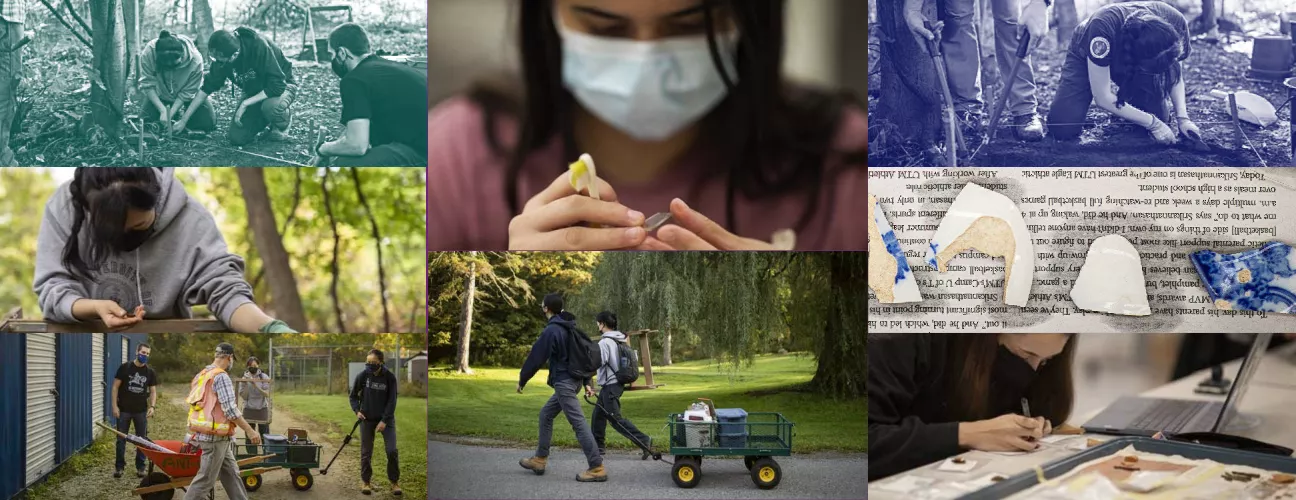
The Mystery of Mount Woodham Project at the University of Toronto Mississauga (UTM) is a joint initiative of the Department of Anthropology, UTM Student Affairs & Services, and UTM Facilities Management & Planning. The project aims to highlight and provide broader outreach on student-involved research at UTM through the example of the Department of Anthropology’s annual archaeological field school. This field and laboratory-based research program, under the umbrella of the Schreiber Wood Project, is examining late 19th century Euro-Canadian occupations on the northwestern section of what is now the UTM campus property.
What and where is Mount Woodham?
In the late 1800s, three houses stood on a site that is now part of the UTM campus (previously Erindale College):
- the first house, Lislehurst, remains occupied
- the second house, Iverholme, was consumed in a fire in 1913 and was never rebuilt, and
- the site of the third house, Mount Woodham, remains unknown.
Students in the archaeological field school continue to discover fascinating clues to help narrow potential locations of Mount Woodham, as well as reveal the past.
Project origins and mission
The Mystery of Mount Woodham Project began in August 2021 through interactions between Dr. Michael Brand and Dr. Trevor Orchard (UTM Anthropology) and Mark Overton (UTM Student Affairs). Mark visited the field component of the field school course and was very taken by the project. The Mystery of Mount Woodham Project was initiated as a means of both extending student experience opportunities and creating some broader outreach around the larger Schreiber Wood Project.
Outreach and displays
The project has provided paid internship opportunities for several Anthropology undergraduate students and alumni who have been working to create four interpretive displays based around the archaeological field school project. These displays will be set up in prominent locations around campus, with content to be rotated regularly:
- UTM Library (display is open)
- UTM Office of the Principal suite (display is open)
- Davis Building, near the Department of Anthropology (display is open)
- A final location for the fourth display case is currently under consideration.
The four initial displays will be set up and available for public viewing in the spring of 2024. The plan is to continue hiring students to develop additional exhibits, increasing the visibility of the project and its contribution to understanding the recent history of the campus.
Project updates
This website will serve as a repository for additional content and links related to the Mystery of Mount Woodham Project. This is a work in progress, and additional content will be posted soon.
Related Links
Video presentation
Watch a brief presentation on the Schreiber Wood Project and the initiation of the Mystery of Mount Woodham Project.
Student research activities
A sample of student research activities related to the Schreiber Wood Project, including a series of research posters presented at academic conferences, can be found on the Schreiber Wood Archaeology web page.
Project Participants
To date, the Mystery of Mount Woodham Project has involved contributions from:
- Kiara Kim, Yunfei Lin and Lilly Maher (UTM Anthropology Undergraduate Students)
- Dr. Michael Brand, Dr. Trevor Orchard, and Kimiko Hill (UTM Anthropology)
- Mark Overton and Yan Tam-Seguin (UTM Student Affairs & Services)
- Afsaneh Tafazzoli, Daniela DiBrigida and Monika Farrell (UTM Facilities Management & Planning)
- Rebecca Tunney (UTM Library; former UTM Undergraduate Student)
- Nicholas Iwanyshyn (UTM Communications)
- Robert Martins (UTM Information & Instructional Technology Services)
The project has also built heavily on the work of other students that have contributed to the Schreiber Wood Project through UTM Anthropology work study and independent research positions; in particular, we note the contributions of Sarah Ranlett, Mahalia Johnna Baguio, Gani Cabezas, Andrew Dasilva Furtado, Karol Guayasamin, Cinda Johnson, Nina Le, Leann Ling, Ya Qi Mo, MacKayla Perry-Wessler, Sarah Sayeed, and Natasa Zdjellar.
